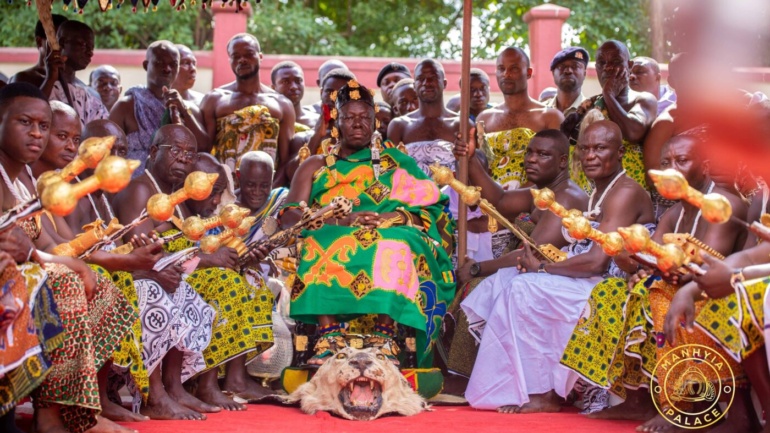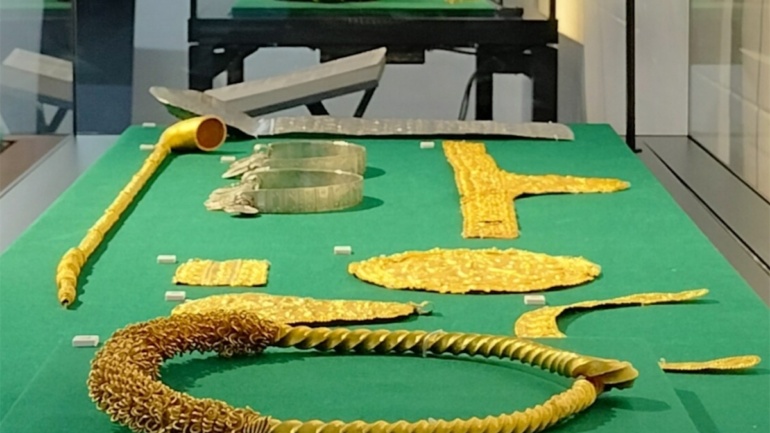In 2024, the V&A commissioned a sculpture to be designed and made by the Asante royal goldsmith, Nana Poku Amponsah Dwumfour, in collaboration with the British Ghanaian artist-goldsmith, Emefa Cole. Unity celebrates a new relationship between the V&A and the Royal Palace in Kumasi, the capital of Asante in modern-day Ghana.

‘Unity’, designed and made by Nana Poku Amponsah Dwumfour, Amankwaa Opoku Benjamin and Emefa Cole, 2025, London, UK, and Kumasi, Ghana. Museum no. M.27-2025. Commission supported by the V&A Americas Foundation. © Victoria and Albert Museum, London
‘When two sides come together’
Unity tells multiple stories. It draws inspiration from the rich symbolism in Asante visual culture, and from Akan proverbs used by the Asante and other ethnic groups in West Africa to promote harmonious relationships. A hollow, gold circle representing the sun houses two entwined gold leaves cradled together. For the Asante, gold is the essence of the sun and the material manifestation of life’s force. The goldsmith chose the proverb ‘Ahata ne ahata ka bɔ mu a, ɛna ɛyɛ pepe’, meaning ‘When two sides come together, it becomes complete’ to promote a spirit of togetherness and to reflect on the collaborative nature of the commission. The gold disc sits atop a bronze tree, representing the origins of the city of Kumasi which translates to ‘under the Kum tree’.

(Left to Right:) Detail of gold circle representing the sun, single gold porcupine representing the Asante King, inside of the tree at the base of the sculpture. © Victoria and Albert Museum, London

(Left to Right:) Detail of porcupines at the base of the sculpture, hallmarks and makers’ marks on the gold circle. © Victoria and Albert Museum, London
Running up the tree towards the sun are small porcupines cast in bronze using historic Asante metalworking techniques. In 1701, the first Asante King (Asantehene), Opemsuo Osei Tutu, established the porcupine as an emblem to signify the nation’s independence. The porcupine, with its sharp, defensive spikes, embodies Asante readiness to protect themselves from all angles. This philosophy of defence and resilience earned the Asante the accolade ‘Asante Kotoko, Wo kum apem a, apem beba’, meaning ‘Kill a thousand, a thousand will rise’. A single gold porcupine represents the Asante King.

Nana Poku Amponsah Dwumfour, known as the ‘Buramuhene’ (King of the Furnace), descends from a long line of master goldsmiths who served previous Asante Kings. He continues to make gold regalia for the King to use at ceremonial occasions, including the Silver Jubilee celebrations in 2024. Asante proverbs and symbolism inform much of his work.
Emefa Cole is an experimental jewellery artist based in London and is the first woman to be apprenticed to the Asante royal goldsmith. From 2022 – 25 she was also Curator of Jewellery (Diaspora) at the V&A. Designed and made collaboratively, the sculpture was created in sections in London and Kumasi before Emefa and Nana worked on it together in the royal workshop in April 2025. It was completed in London in July 2025.
Materials and making

(Left to Right:) Early design drawings in the development of the sculpture; carving of the tree in wax in Emefa’s studio. © Victoria and Albert Museum, London
Unity is made from gold, bronze and silver, and the inside of the tree is coated in pure gold leaf. The gold used in the sculpture was mined in Senegal’s Sabodala-Massawa mine by Endeavour Mining for Single Mine Origin (SMO), which is part of the Betts Group. This means that the gold is fully traceable to a single, responsibly-managed mine, and ensures ethical and transparent sourcing practices from the mine to the finished work. The bronze alloy for the porcupines was specially created by the refinery to match the bronze used to cast the tree.

(Left to Right:) The gold sheet is prepared for the golden circle; Emefa working on the hollow gold circle. © Victoria and Albert Museum, London
The sculpture was made using a combination of traditional gold and silversmithing and bronze casting techniques. The tree was first carved in wax by Emefa and then cast by Chris Nash at Arch Bronze Casting in London. The gold disc was made by Emefa and gold and silversmith Clive Burr from two sheets of 18 carat gold, and was blocked and planished (flattened) into shape before being soldered together. The disc was then finished and polished to create a silky surface. The engraved leaves were made by the Asante Royal Goldsmith in Kumasi from sheet gold before they were soldered together and attached to the stem.

(Left to Right:) The bronze is melted for casting the porcupines; the porcupines are cast using the lost-wax technique; the porcupines after casting with the channels for wax still attached. © Victoria and Albert Museum, London
The porcupines were made using the technique of historic Asante lost-wax casting. This method involves making a model of the porcupines in beeswax, which is then covered in a mixture of clay and charcoal. The encased model is heated and the wax is melted out, leaving channels for the heated liquid bronze to run into the void to create the form of the porcupines. Once cool, the porcupines were then cleaned and soldered onto the tree. The gold porcupine was made later in London using the technique of sand casting. A silver disc fills the top of the trunk of the tree and pure gold leaf coats the interior. The multiple elements were then brought together and supported by a gold ‘staff’ (rod), representative of the staff carried by the Asante linguist (Okyeame) at public events to signify their authority.

(Left to Right:) Emefa and the team cleaning up the inside of the tree; the first few porcupines soldered onto the tree. © Victoria and Albert Museum, London
The collaborative nature of this commission brought together the two makers’ expertise. They also worked closely with Nana’s son Amankwaa Opoku Benjamin and many other collaborators in Kumasi and London to realise the sculpture.

(Left to Right:) Nana holds the nearly completed leaves; Amas cleans the sculpture once all of the porcupines have been soldered on. © Victoria and Albert Museum, London
This sculpture marks a momentous milestone in the ongoing collaboration between the V&A and Manhyia Palace. I am honoured to have worked alongside Nana on this project and extremely thankful to the Asantehene for his ongoing support and for granting me unprecedented access to the historic workshop and to the royal goldsmith. This is especially pivotal given that women are not traditionally allowed to work in this space. It is a wonderful privilege to have been able to coordinate this by bringing together expert craftsmen from the United Kingdom and Ghana to create this healing work of art. It teaches us that we can work together to create a better world than the one we inherited.
Emefa Cole, 2025
A new spirit of cooperation
Unity marks a new relationship between the V&A and Manhyia Palace Museum, the home of the Asante King. While the V&A has never systematically collected West African metalwork, a small but significant collection of Asante royal regalia has been in the collection since 1874. In April that year, the museum acquired 17 items from hundreds of pieces of gold looted two months earlier by British troops when they raided Kumasi during the third of the so-called Anglo-Asante Wars. For the Asante, the gold regalia contains the spirits of former kings and carries meaning deeply embedded in Asante identity.
The National Heritage Act of 1983, under which the V&A is governed, contains no provision for the V&A to return items like the Asante gold regalia that were acquired through 19th-century imperial conflict. Even so, there is much we can do within this regulation. In the summer of 2023, the Asante King, Otumfuo Osei Tutu II and his Chief Advisor, Ivor Agyeman-Duah met with the V&A and the British Museum to discuss a tripartite agreement to display in Kumasi selections of the Asante gold from both museums as a long-term renewable loan. Following this, the V&A entered into a Renewable Cultural Partnership with Manhyia Palace Museum that supports exchanges of knowledge and skills beyond a simple loan. A new exhibition of the historic regalia called Homecoming opened on 1 May 2024. All 17 items of Asante gold regalia in the V&A, along with 16 from the British Museum, went on display in Kumasi for the first time in 150 years. The gold was greeted personally by the King, who opened the exhibition.

‘Unity’ on display in the V&A’s Metalwork gallery. © Victoria and Albert Museum, London
Unity marks a further step in this Renewable Cultural Partnership – it acknowledges the history of conflict that brought the V&A and Manhyia Palace Museum together but its creation and symbolism point to a future based on cooperation and friendship. It builds on Nana’s and Emefa’s pre-existing collaboration to promote the sophisticated techniques of historic Asante goldsmithing and fuse it with contemporary making. Its backing by the Asante King and its creation with Single Mine Origin gold enables the V&A to better represent global practice in the collection of contemporary metalwork and to show objects with a clean provenance all the way from the mine to the museum.
Find out more about the history of the Asante gold regalia in the V&A’s collection.
Discover more about the Manhyia Palace Museum and Homecoming exhibition.
The sculpture was made with support from the V&A Americas Foundation. The makers would like to thank the following people in their support of the making of the commission: Charlie Betts, Clive Burr and Junko Adachi of Clive Burr Silversmiths, Harvey James-Park, Grace McNamara, Benjamin Hawkins, Amankwaa Opoku Benjamin, Akwasi, Nana Yaw, Kofi Owusu and Kofi.





